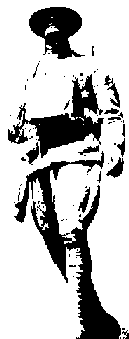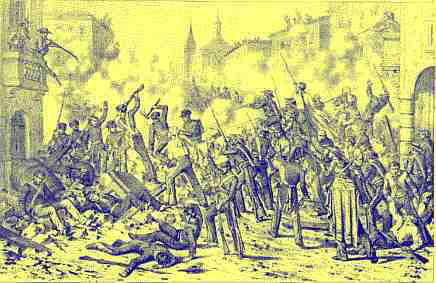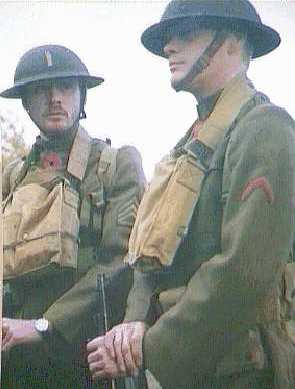
The Story of the American Expeditionary Forces
|

|
THE ORIGINS
OF
DOUGHBOY
|
An Interim Report
By Website Editor Michael E. Hanlon
Later Revisions/Additions in Red


A. The Coinage of Doughboy
For us today, and maybe for all Americans who will follow, the Doughboys were the men America sent to France in the Great War, who licked Kaiser Bill and fought to make the world safe for Democracy.
The expression doughboy, though, was in wide circulation a century before the First World War in both Britain and America, albeit with some very different meanings. Horatio Nelson's sailors and Wellington's soldiers in Spain, for instance, were both familiar with fried flour dumplings called doughboys, the predecessor of the modern doughnut that both we and the Doughboys of World War I came to love. Because of the occasional contact of the two nation's armed force and transatlantic migration, it seems likely that this usage was known to the members of the U.S. Army by the early 19th century.

Nelson and Wellington
Their Men Knew About Doughboys
Independently, in the former colonies, however, the term had come to be applied to baker's young apprentices, i.e. dough-boys. Again, American soldiers probably were familiar with this usage, but were also possibly inclined to use it in a mocking fashion. The New World version of doughboy was a linguistic cousin to "dough-head", a colloquialism for stupidity in 19th Century America. Reader Judith Kerman, Professor of English at Saginaw Valley State University, points out that, in Moby-Dick (Ch. 34ff), Melville nicknames the timorous cabin steward "Doughboy." This important 19th Century literary usage suggests a negative comparison of the steward's pale face to the darker faces of the sun-burnt whalers and "savage" harpooneers. When doughboy was finally to find a home with the U.S. Army it initially had a similar disparaging connotation, used most often by cavalrymen looking down [quite literally] on the foot-bound infantry.
In examining the evolution of doughboy these pre-existing streams of application need to be kept in mind. There is, however, an absence of literary citations clearly connecting either to the American miliary. Doughboy as applied to the infantry of the U.S. Army first appears, without any precedent that can be documented, in accounts of the Mexican-American War of 1846-47.
B. The
Doughboy as American Infantryman
 The First Doughboys Capture Monterey, Mexico
The Random House Historical Dictionary of American Slang cites several sources from the War with Mexico showing doughboy to be a nickname for the infantry including:
We "doughboys" had to wait for the artillery to get their carriages over.
N.J.T. Dana [An infantryman]
No man of any spirit and ambition would join the "Doughboys" and go afoot.
Samuel Chamberlain [A Dragoon]
Sources like these clearly put to rest both the oft-stated proposition that doughboy as we mean it here was first applied in the Civil War and also the wilder suggestion that the usage was somehow a creation of the noted "Cavalry Couple", General and Mrs. George Armstrong Custer. Both the Civil War and the Custers did help in spreading the use of doughboy. Clearly from the number of Civil War citations that can be identified, the term became known to a much wider audience because of the size and scope of the later conflict. The Custers, being the shameless self-promoters they were, probably can be credited for popularizing it as well because of its appearance in their published letters.
Somewhere, however, on the march back from Mexico's Halls of Montezuma, any definitive evidence explaining the new use of doughboy was waylayed. For the next 150 years lexicographers from H.L. Mencken to the editors of the Oxford English Dictionary would speculate on the reasons for the labeling of U.S. infantrymen as doughboys. Despite their distinguished achievements they all have the same dual problem as the present writer: there just are not a lot of reliable primary sources from that period and, of course, none of us were there. Absent the discovery of new material from the 1840s, an exploration into the origins of doughboy has but one way to proceed -- looking at the pros and cons of the plausible theories and weighing the evidence. There are four such explanations each with their school of advocates, each with weaknesses in either evidence or logic.
The Baked Goods Theory: One suggestion is that doughboys were named such because of their method of cooking their rations. Meals were often doughy flour and rice concoctions either baked in the ashes of a camp fire or shaped around a bayonet and cooked over the flames. This interpretation also suggests the baker's helper tradition of doughboy. Samuel Chamberlain [quoted above] adhered to this theory in his memoir My Confessions. This has to be taken with some reservations, however. His memoir was written after the war in the 1850s and reworked by later editors.
 Two of Pershing's Doughboy Reenactors Chatting
The weakness of the "Baked Goods" theory lies in the question as to why this would come to only apply to the infantry. Did artillery gunners and quartermasters prepare their food differently? Were the infantry the only soldiers who had to cook their own food in the field?
The Button Theory: At this writing, it has been impossible to confirm one assertion of one branch of doughboy theorists and it is the proposition on which their entire case sits. It is that U.S. infantrymen wore coats with unique, globular brass buttons. In one variation of this theory the buttons are said to reminiscent of the doughboy dumplings eaten by the soldiers and sailors of earlier days and which possibly had become part of American cuisine. In another variation, drawing additionally on the Baked Goods Theory, it is said that the product of the infantrymen's cooking efforts came to resemble the buttons on their uniforms.
Most adherents of this approach seem to base their argument on the uniforms of the Civil War period. Since this usage of doughboy predates the Civil War, these advocates have a timing problem. More research on the uniforms of the earlier war is needed; if it is discovered that such buttons were not part of the foot soldiers' uniform in the Mexican-American War the Button Theory would be effectively undermined. As of February 2002 I have been contacted by a museum which displays military uniforms, informing me that US infantry uniforms of the period did, indeed, have globular buttons. I am awaiting confirming photos. But even if the claims about uniform buttons are validated, there is still a lack of primary evidence backing up this line of thinking.
The Pipe Clay Theory: During the 19th Century American enlisted men used a fine whitish clay called pipe clay to give "polish" to their uniforms and belts. It was a less than perfect appearance enhancer, however; in rainy weather the saturated clay came to look "doughie". Infantrymen would be more vulnerable to this effect as their comrades kicked up mud and dirty water from the many puddles they would march through. One reader has offered a variation on this from the memoirs of General Bliss. The General writes that flour [dough?] was used for this whitening function by the infantrymen along the Texas border from where the invasion of Mexico was launched.
The Pipe Clay theory, championed in our century by Mr. Mencken, has plausibility, but lacks documentation. [General Bliss's variation is a singular report that might have been subject to distortion over time, so it also needs corroboration.] On the main point, shouldn't there be some description of troops marching in the rain, looking "doughie", to support this? Besides, the routes the infantry took in Mexico tended to be dry and dusty rather than wet and muddy and this leads us to the final of the four theories.
The Adobe Theory: In a nutshell - in marching over the parched terrain of the deserts of Northern Mexico the infantry stirred up so much dust that they took on the look of the adobe buildings of the region -- hence, [after a few phonetic adjustments] doughboys. The cavalrymen who rode horses, the artillerists who rode caissons and the quartermasters who rode wagons were all mounted above the worst of the dust cloud. It is also easy to visualize them collectively indulging in a little disparagement at the expense of their suffering colleagues.
 Americans Marching in Northern Mexico
This theory has possibly the best "fit" to the facts of the campaign in Mexico as known, yet it has no backing from the historical record. It appears to be the product strictly of 20th century speculation. Nevertheless, it is the favorite theory of doughboy chronicler Laurence Stallings and of this writer as well. The modern day Oxford English Dictionary Supplement takes a reverse slant and suggests that the marching infantry pounded their dirt pathways into dough, but that does not quite ring true to anyone who has visited Mexico. In the northern parts, if it's not paved, it's dusty.
C. From Chapultepec to the Rhine
For the next 70 years following General Scott's capture of Mexico City, doughboy, despite its uncertain origins, was used -- sometimes mockingly -- as a nickname for the American infantryman. It appears in first-hand accounts from the Civil War, the campaigns on the frontier and the Philippine Insurrection. Doughboy Drill became synonymous with close-order infantry drill and supplies of prophylactics for soldiers on pass became known as Doughboy Kits.
 Far from Mexico
A Lone [Marine] Doughboy Guards the Rhine, 1919
Yet when the Great War and America's entry into it came, the usage of doughboy changed dramatically and we are left with some additional doughboy mysteries. Somehow, in a mere nineteen months, doughboy became the universally popular nickname of all the American troops sent to Europe pushing "Yanks" [recall that in the hit song Over There it was the "Yanks" who were coming...] and the media inspiration of the moment "Sammies" [after Uncle Sam] to the sideline. Also, it became generalized in application, no longer limited to the infantry. All the army combat branches, aviators, logistical support troops and even the U.S. Marines [to their chagrin] were individually and collectively labeled doughboys.
It seems to have been a bottoms up movement. In their letters home and their diaries volunteers, draftees and national guardsmen of every specialty just began referring to themselves as Doughboys. Their overseas newspaper, The Stars & Stripes, freely used and advocated the term as well. I was also shown a quote recently indicating that General William Siebert, first commander of the 1st Division and later chief of Chemical Warfare strongly encouraged the usage of doughboy.
And there is one final puzzle or maybe a bit of magic about the use of doughboy during the World War. Doughboy came to belong exclusively to the 4.7 million Americans who served in the Great War. The Army continued using some of the slang terms like Doughboy Drill, but the troops of the 20s and 30s, for the most part, did not use the term to describe themselves, nor did the public. In the Second World War the Doughboys' sons called to arms in stupendous numbers would be alternately known as the Yanks and GIs. Possibly the sad Bonus Marcher incident of the early 1930s [the veterans were all former doughboys] played a role in de-popularizing the usage, but maybe America just decided the name "belonged" to the boys of the First World War.
My 2009 Surprise. Eleven years after I wrote the original version of this article I was asked to be the Master-of-Ceremonies at an event at the National World War I Memorial in Kansas City honoring Mr. Frank Buckles, who is the lasting surviving American Doughboy of World War I. It was a very moving experience for me, I've thought a lot about the great generation for whom Mr. Buckles has been such a wonderful representative since I wrote this piece.
At this writing, this is as much as I can say about the origins of doughboy and its use in the Great War. This is an interim report, though, and I hopeto update it continually.
D. Call for Contributions
To advance the investigation into the origins and usage of doughboy, more hard evidence is needed. If you have primary, documentary material from the pre-Civil War period, supporting or challenging any of the four theories please send it to me at the address below. Any help on the uniforms of the Mexican-American War also would be welcomed. To study the popularizing of the expression during the Great War, I am interested in public utterances using doughboy immediately after America's entry into World War I and during hostilities. These could be speeches, newspaper accounts or written material by public persons.
|
|
Sources and thanks: I consulted every dictionary I could find in the Contra Costa County, California Library System. The works mentioned specifically in the text were likely marginally more helpful than the other works. Duncan Aram and Ray Mentzer contributed photos and the two scenes from Mexico were found at a website on the Mexican-American War that apparently no longer exists. A special thanks to the 200+ people who have written me over the year with suggestions for the article and the thousands who have thanked me for making this material available. The article is cited and in a number of books and websites (often without attribution, but that's OK). Also, I must remember a GWS Member, the late Gerry Devereux, who kept asking why doughboy became so darn popular in the First World War. MH
|
To find other Doughboy Features visit our
Directory Page
|
For Great War Society
Membership Information

Click on Icon |
For further information on the events of 1914-1918
visit the homepage of
The Great War Society
|
Additions and comments on these pages may be directed to:
Michael E. Hanlon
(medwardh@hotmail.com) regarding content,
or toMike Iavarone (mikei01@execpc.com)
regarding form and function.
Original artwork & copy; © 1998-2000, The
Great War Society
|








